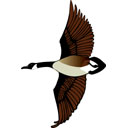
|
|
|
|

Once known as "Buffalo bird", the Brown-headed Cowbird now attends livestock,
inhabits fields, farmlands and backyards. It is approximately 7 1/2"
long with a stubby, conical bill and relatively short tail. The male is
glossy black with a brown head. Females are smaller and a dull greyish
brown color. Juveniles are similar but streaked below. The male’s song
is a squeaky gurgling, usually ending with a few high, squeaky whistles.
The female’s chatter is often given in unison with the male’s song during
courtship. Calls include a harsh rattle or chatter, usually given by the
female, a short chuck note given by both sexes when alarmed, and
squeaky whistles given by the male, especially in flight. The loud begging
calls of fledgling cowbirds are distinctive.They are abundant birds in
nearly all of North America.

For most birders the cowbird strikes fear in their hearts for it is best
known for parasitising the nests of other species. It does not build it's
own nest; rather it deposits it's eggs in other bird's nests, especially
those of flycatchers, warblers, finches and vireos. It has actually been
recorded as a parasite of more than 200 other species. They do not raise
their own young but leave that up to their hosts. The Cowbird eggs do not
usually mimic the host eggs in appearance nor do the young push out the
host eggs and young from the nest as some other parasitic birds do such
as the European Cuckoo. But Cowbirds do tend to hatch earlier than their
hosts, grow faster, and crowd out or at least reduce the food intake of
the host's young.

Cowbird egg in Chipping Sparrow nest.
Of deep concern is their parasitising the nests of endangered species like
the Kirtland's Warbler which is found exclusively here in Michigan
in only six counties. Cowbirds have been abundant in Kirtland's habitat
only recently as forests in the area were cleared for agriculture. The
warblers are not adapted to defend against them. The percent of parasitized
nests increased from about 55% in the 1940's and 50's to over 70% in the
1960's.
It
is an especially dangerous enemy because of the fact that it parasitizes
numerous species and is therefore not dependent on Kirtland's Warbler.
As it reduces the warbler population, its own population size will not
necessarily decline- its assault can be unrelenting. Thus when the decline
in warbler populations was observed, the U.S. Fish and Wildlife Service
along with several state agencies and the Detroit and Pontiac Audubon Societies
began a program of trapping and removing cowbirds. By about 1980 over 40,000
cowbirds had been removed, and as a result the level of parasitism of warbler
nests became negligible. Kirtland's fledging rates have tripled, so that
their nesting success is now higher than that known for any other warbler.
By 1977 the decrease in warblelr numbers had clearly been halted and 219
singing males were counted.
The future of Kirtland's warbler remains in doubt however. Even with
the cowbird control program, more conservation methods are needed if the
species is to be saved. The only long-range solution is to maintain enough
habitat in Michigan for them to persist without constant human interference
and keeping their West Indian wintering grounds in suitable condition.
![]()
If you'd like to "read more about it" check
out this link at the Mining Co. for
"Everything
About Cowbirds ".
Or check out Peterson's Online Kirtland's Warbler site
![]()
To see other Bird
of the Month pages click on the month.
Feb.
March

Back to Wings
Over Michigan Homepage
This page created March 31, 1999